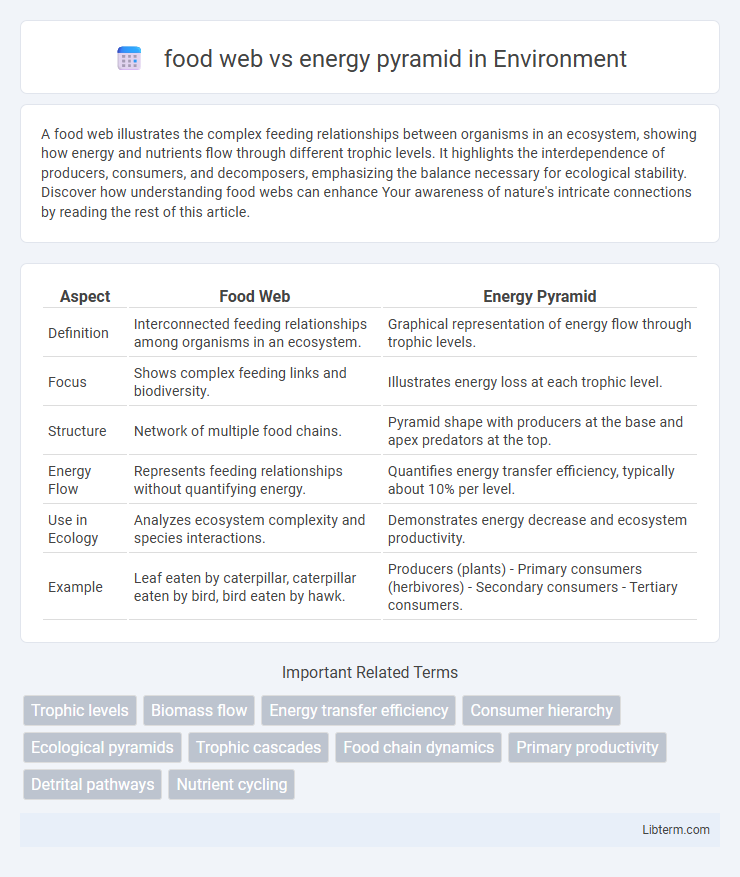A food web illustrates the complex feeding relationships between organisms in an ecosystem, showing how energy and nutrients flow through different trophic levels. It highlights the interdependence of producers, consumers, and decomposers, emphasizing the balance necessary for ecological stability. Discover how understanding food webs can enhance Your awareness of nature's intricate connections by reading the rest of this article.
Table of Comparison
| Aspect | Food Web | Energy Pyramid |
|---|---|---|
| Definition | Interconnected feeding relationships among organisms in an ecosystem. | Graphical representation of energy flow through trophic levels. |
| Focus | Shows complex feeding links and biodiversity. | Illustrates energy loss at each trophic level. |
| Structure | Network of multiple food chains. | Pyramid shape with producers at the base and apex predators at the top. |
| Energy Flow | Represents feeding relationships without quantifying energy. | Quantifies energy transfer efficiency, typically about 10% per level. |
| Use in Ecology | Analyzes ecosystem complexity and species interactions. | Demonstrates energy decrease and ecosystem productivity. |
| Example | Leaf eaten by caterpillar, caterpillar eaten by bird, bird eaten by hawk. | Producers (plants) - Primary consumers (herbivores) - Secondary consumers - Tertiary consumers. |
Introduction to Food Webs and Energy Pyramids
Food webs represent the complex network of feeding relationships among organisms in an ecosystem, illustrating how energy flows through various trophic levels. Energy pyramids visually depict the amount of energy available at each trophic level, decreasing sharply from producers to top consumers. Understanding the connection between food webs and energy pyramids highlights the efficiency of energy transfer and the interdependence of species within ecosystems.
Defining the Food Web
A food web is a complex network of interconnected food chains that illustrates the feeding relationships and energy flow among various organisms within an ecosystem. Unlike an energy pyramid, which quantifies energy transfer and loss at each trophic level, the food web emphasizes the diversity and interdependence of species, showing multiple pathways through which energy and nutrients circulate. Identifying producers, consumers, and decomposers within the food web reveals the intricate balance sustaining ecosystem stability.
Understanding the Energy Pyramid
The energy pyramid illustrates the flow of energy through trophic levels, highlighting that energy decreases by approximately 90% at each successive level from producers to apex consumers. This model emphasizes the efficiency of energy transfer in ecosystems, where only a fraction of energy consumed by one level is available to the next. Understanding the energy pyramid is crucial for recognizing the ecological limits on population sizes and the sustainability of food webs.
Key Differences Between Food Webs and Energy Pyramids
Food webs illustrate the complex feeding relationships among organisms within an ecosystem, showing multiple interconnected food chains and energy flow paths. Energy pyramids represent the hierarchical levels of energy transfer from producers to apex consumers, emphasizing energy loss at each trophic level. Key differences include the depiction of complexity versus simplicity, with food webs highlighting diverse interactions and energy pyramids focusing on quantitative energy distribution.
Trophic Levels: Structure and Flow
Trophic levels in a food web represent the complex feeding relationships and energy transfer among producers, consumers, and decomposers, illustrating multiple interconnected pathways of energy flow. The energy pyramid simplifies this by showing a hierarchical, linear structure where energy decreases significantly at each ascending level due to metabolic losses, with producers at the base supporting primary consumers, followed by secondary and tertiary consumers. Understanding these structures reveals the efficiency of energy transfer and the dynamic balance within ecosystems.
Energy Transfer Efficiency in Ecosystems
Energy transfer efficiency in ecosystems is significantly higher in food webs compared to energy pyramids due to the complex network of feeding relationships that allow multiple energy pathways. Food webs demonstrate that energy flows through various trophic levels simultaneously, optimizing energy utilization among organisms, whereas energy pyramids depict a linear and less efficient 10% energy transfer between each trophic level. Understanding these differences highlights the importance of biodiversity and interconnected species in maintaining ecosystem energy dynamics and stability.
Real-World Examples of Food Webs
Coral reef ecosystems demonstrate complex food webs where multiple species such as herbivorous parrotfish, predatory groupers, and zooplankton interact, illustrating energy transfer across trophic levels. In African savannas, food webs encompass grasses, herbivores like elephants and zebras, and apex predators including lions, showcasing diverse feeding relationships. These real-world examples highlight the intricate connections within food webs, contrasting the linear progression depicted in energy pyramids.
Visualization of Energy Pyramids
Energy pyramids visually represent the flow of energy through trophic levels, starting with producers at the base and ascending to apex consumers, with energy decreasing at each level due to metabolic losses. Unlike food webs that illustrate complex feeding relationships among organisms, energy pyramids quantify energy transfer efficiency, highlighting biomass and energy availability in ecosystems. The broad base and narrow top structure of energy pyramids emphasizes the significant energy loss, generally around 90%, between levels, crucial for understanding ecosystem productivity.
Limitations of Each Model
The food web model oversimplifies intricate feeding relationships by often neglecting energy flow efficiency, which limits its ability to quantify ecosystem productivity accurately. The energy pyramid illustrates energy transfer across trophic levels but fails to capture species diversity and the complexity of interactions within an ecosystem. Both models provide valuable insights yet have inherent limitations in fully representing ecological dynamics and energy distribution.
Importance in Ecological Studies
The food web illustrates complex feeding relationships and energy flow among multiple organisms, providing a comprehensive understanding of ecosystem dynamics. The energy pyramid quantifies energy transfer efficiency across trophic levels, highlighting energy loss and biomass distribution within an ecosystem. Studying both models is crucial for ecological research, as they reveal the interdependence of species and the sustainability of energy resources in natural habitats.
food web Infographic

 libterm.com
libterm.com